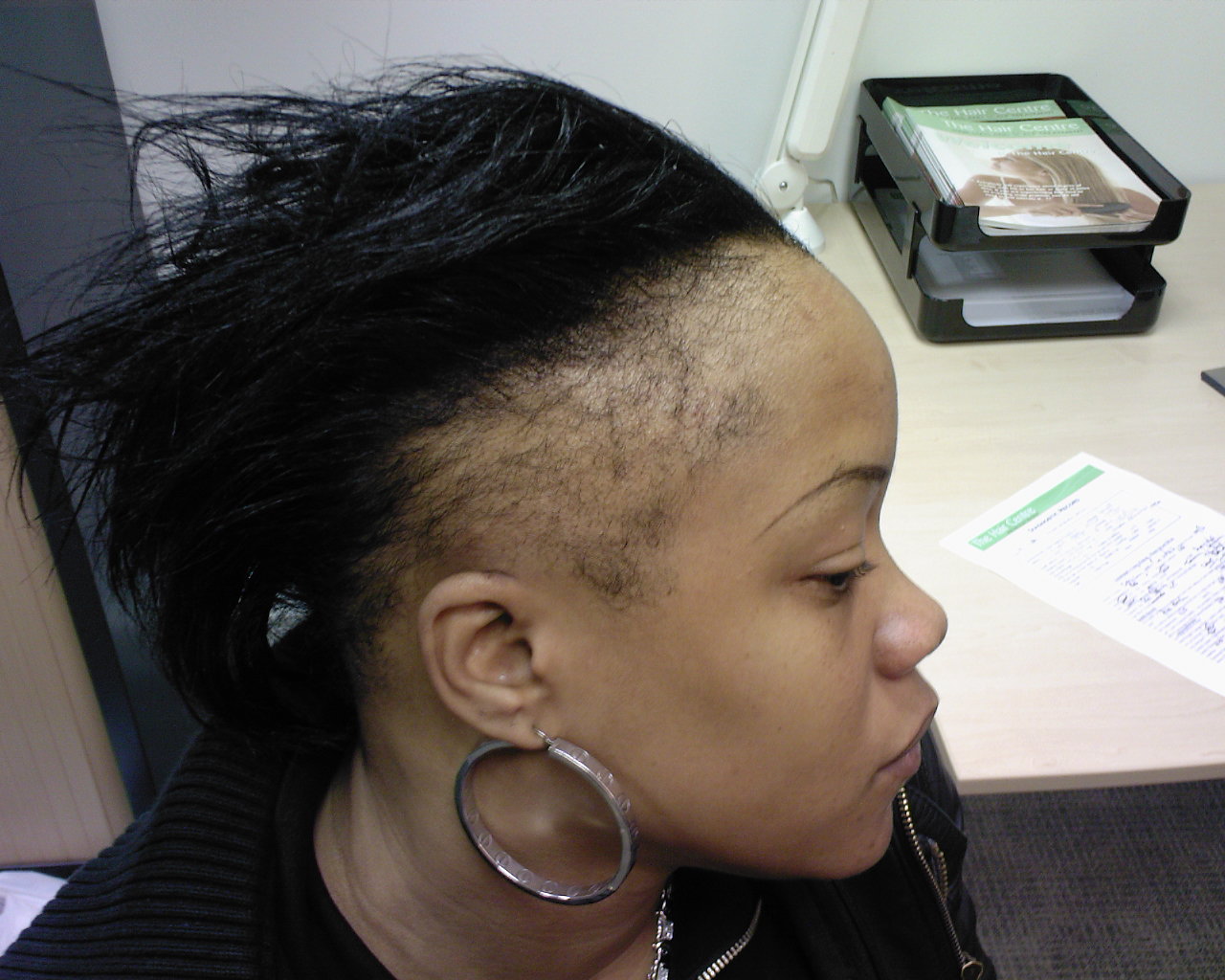Back Again,
ThaBadbrey Cosmetologist Says;
I would like to address an area of hair growth that most individuals seem to neglect. This would entail that of the “Edges” (The Hair-Line) and the “Nape” (The area where the hair on our head meets the “Neck-Back!…lolol”).
Many seem to have great difficulty in preventing these areas from experiencing breakage on a regular basis. This usually occurs when Plaits/Extensions/Weaves/Ponytails are far too tight for these delicate areas to cope with. As you may or may not know already, these regions of our “Head-Tops” are much more fragile than our already somewhat, breakage prone textured hair types.
Now I’m sure most of you have experienced walking down the street and witnessing a “Yardfied-Woman” with “Bleach-Out” skin (Or what I like to call “White-Face & Black Foot”) who has chosen to adorn a “Yardified-Hair-Style” usually in the form of some form of “Extensions” or a “Weaved-On” type of style. (This is a hypothetical example, it is not my intention to vilify or offend any so-called Yardies in any way, additionally, no yardies where hurt during the creation of this document. I only wish to highlight the bad hair care practises of many members of the black community, these include all black women, and men, from nearly all areas of the world, I have just chosen to scapegoat the “White-Face & Black Foot” individuals in this instance…lololol) . My point is, that usually, upon closer inspection of the aforementioned hair style being sported by the aforementioned archetypal member of society, it is obvious that the “Edges” and/or “Nape Area” of the individual in question are/is usually in decline (or receding).
In extreme cases these areas are virtually none existent and thus, causes this societal member to feel the need for the hastened “Slicking-Down” of these regions, in a somewhat feeble attempt to hide the fact that the hair in this part of the head is breaking badly. (This “Slicking-Down” is usually carried out via the utilisation of some type of styling gel that is usually far too acidic for the skin protective “Acidic-Mantle” to cope with, thus causing pH Imbalance and thus, MORE BREAKAGE!, and THUS!, the vicious spiraling cycle continues. It hurts me when I see a young girl aged around 6 to 10 years of age with virtually no edges and a badly broken nape because of bad hair care practices. Education is the key to repair this too often neglected area of health within our community.)
Whilst a receding hair line may be a hereditary genetic trait, as in the case of hereditary baldness, it is safe to say that “Bad Hair Care Practises” are usually to blame when this type of breakage occurs more extensively within this region of the scalp.
Possible Solutions to these problems are as follows;
When Plaiting/Braiding the hair, try to either EXCLUDE these regions of the scalp from being involved altogether or, if the hair in this area is long enough, include it within the Plait, but only at an extremely loose level of tightness. Any undue, extreme stress and strain will cause these hairs to be pulled from the follicles within the scalp prematurely, and may lead to a receding hair-line (Or as I like to describe it “Your Wig Being Push back”) that may not necessarily be an inherited genetic trait. (Usually passed down genetically from one or more of your parents who may or may not have a hairline synonymous to that of Lieutenant Commander Tuvok from Star-Trek Voyager) .
See Picture below for Illustrative Photographic Description of Mr Tuvok, the Master of the “Push Back Wig” hair style.;
Anyway,
After styling has taken pace to the main region of….the head…lol, the “Edges” and “Nape” (Hair pon the Neck Back) may be left free flowing and without style. An option may be to slick down the “Edges” with a Gel that falls within healthy pH parameters or, you can use one of my manufactured hairsprays courtesy of ThaBadbrey Herbal to “Spritz” them, and then follow up by sealing the region with an Essential Oil mixed with a Carrier Oil of your choice. If the latter suggestion is “Long” for you, you may wish to resort to the former option of “Bunnin’ Out your head top” with some type of “waaay” to acidic Styling Gel of your choice although, I will not recommend it. Additionally, you may devise your own healthy hair care method of “Slicking Down” these hairs.
Now,
The “Nape” is usually prone to even more breakage due to its location. The back of the neck is subject to rubbing against clothing (Collars, Scarves, Hats…etc, unless of course, all of your clothing is made from pure silk of the highest quality) as well as harsh abrasive materials found upon furniture utilised for seating practises. In order to protect this area, it is imperative that the hair, when long enough, is styled into small twists (tight Plaits/braids in this area may cause unintentional knotting when unravelling/de-plaiting and could lead to more unwanted breakage, however, loose plaits/braids or cane rowing/corn rowing could be employed here as long as it is not done to TIGHTLY, as it will defeat its whole protective purpose) as this will protect them from abrasive materials and breakage due to their collective tensile/structural strength. This “Strength in Numbers” concept also aids and promotes growth. it is advisable to provide the nape with the same, if not more, care as the rest of the hair strands on the head in terms of moisture/protein balancing. In time and with great patience and perseverance, the “Nape” will grow and thrive. (My nape never grew to more than a few centimetres for years until I realised what the problem was and began protecting it through protective styling methods. Then within a few months I gained a good couple’ inches, I couldn’t believe that the solution was that simple.)
Ha!!!!
When pulling hair back into a Ponytail, do not pull to tightly, after application, you should be able to move your head in all extreme directions without feeling any pulling in any area of the head, especially the most delicate parts of the scalp. Hair bands should only be doubled up once, not multiple times as this causes too much stress on the hair strands which may eventually lead to a greater chance of structurally induced breakage. You should be able to stick your finger underneath the Ponytail whilst it is fastened, if you cannot do this then the Ponytail is too tight! If the hair is too short to be pulled back into a Ponytail, DO NOT FORCE IT!!!, use “Bobby Pins” or Hair Clips instead until the hair is long enough to reach into the desired style.
If your hair is chemically treated, all of the above mentioned methods of protection can still be utilised, however, I must address the following;
When chemically treating the hair, either, completely exclude the “Edges” and the “Nape”, or apply the chemical treatment to them last. This will allow these areas to avoid the harsh chemicular (is that even word …lolol) environment that the rest of the hairs on the head are being subjected to. As these areas are already much more fragile and more prone to breakage, if they are treated last they will be subjected to these harsh conditions for the least amount of time and thus, have an even smaller chance of being damaged, and THUS!!!, resulting in a greater chance of being able to thrive and grow to their full potential.
One more thing before some of you fall asleep (No Pun Intended), before venturing off into slumber land, it is advisable to wrap your head or more to the point, hair in some type of protective head wrap made from a smooth material, preferably silk or satin. This will protect both your delicate “Edges” & “Nape” as well as the rest of the hair on your head from breakage caused by the rubbing of the usually cotton fabrics found in bed covering materials (unless of course, you have a satin or silk pillow case, duvet cover, bed sheet and night gown/pyjamas).
Satin Head Wraps can be purchased at the majority of Cosmetic Beauty Stores or ordered online.
So when Busta-Rhymes says, “Protect Your Neck!!!!”, take it as some type of reminder to;
Protect those “Edges”, as well as that “Nape!!!!!!”
Shown Below, is a Somewhat “Graphic” Image of Severe “Traction-Alopecia”, Induced as a Detrimental Result, of having Badly Styled Weaves Regularly Applied to the Scalp Over a Pro-longed Period of Time;
Don’t Let this happen to you:
Sometimes “Edges” and/or “Nape” can be permanently damaged beyond repair and never grow back!!
And, if you choose to sport a “Weaved-On” style DO NOT, I REPEAT, DO NOT USE GLUE IN YOUR HAIR OR IN YOUR SCALP, IT IS A RECIPE FOR DISASTER!! IT IS EXTREMELY DANGEROUS TO APPLY THIS FORM OF ADHESIVE TO ANY PART OF YOUR ANATOMY, ESPECIALLY TO AN AREA AS SENSITIVE AS THE SCALP!!!
Anyway,
Please Continue to adopt “Good Hair Care Practises”, it will benefit you greatly in the Long-Run.
Yours Truly,
ThaBadbrey Cosmetologist
All Rights Reserved ©ThaBadbrey Herbalist 2012
Courtesy of ThaBadbrey Herbal.

